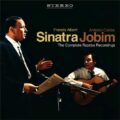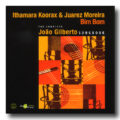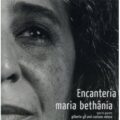Sinatra/Jobim: The Complete Reprise Recordings
Posted on Friday, July, 2, 2010 | Comments Off on Sinatra/Jobim: The Complete Reprise Recordings
Frank Sinatra released dozens of albums for the Reprise label beginning in 1961. Every once in awhile he would share equal billing with the likes of Bing Crosby, Duke Ellington, Count Basie, and the co-subject of this review, one A.C. Jobim. Antonio Carlos Jobim was a popular Brazilian songwriter, composer, arranger, vocalist, guitarist, and piano player. Immensely respected in his home country, he gained commercial acceptance in The United States for his albums with Stan Getz and Astrud Gilberto. Their first 1964 project together won four Grammy Awards and helped to introduce the Bossa Nova to American music fans. Sinatra and Jobim went into the studio together during 1967. Francis Albert Sinatra & Antonio Carlos Jobim,, with Jobim providing backing on guitar, piano, and vocals, was released during March and would be a commercial success reaching number 19 on The American pop charts. Nearly two years later, during February 1969, they returned to the studio and recorded ten more tracks for a follow-up album. Sinatra-Jobim was quickly released and then just as quickly withdrawn per Sinatra’s instructions. Only a few odd copies managed to escape destruction. 1971’sSinatra & Company would include a number of these withdrawn tracks, but the rest disappeared into the Reprise vaults and would not see the light of day until they were issued on a box set several decades later. The Concord Music Group has now released Francis Albert Sinatra & Antonio Carlos Jobim: The Complete Reprise Recordings, which gathers all of their recorded songs into one place. The performances obviously have a Latin flavor both in terms of sound and song selection, but Sinatra’s interpretive style pushes them into the pop style of music. Jobim co-wrote seven of the songs for their first release and co-wrote all ten for the second. “The Girl From Ipanema,” “Once I Loved,” “Meditation,” “The Song Of Sabia,” “One Note Samba,” and...
Gabriela Anders
Posted on Wednesday, June, 30, 2010 | Comments Off on Gabriela Anders
Gabriela Anders was born into a family of musicians. The Argentinean native studied classical guitar and piano in Buenos Aires while listening closely to her father, jazz saxophonist Jorge Anders. “There were so many influences when I was growing up, and I wanted to do something with them all. My father’s concerts and studio work certainly affected me, as did the music of Brazil— it’s so harmonically rich and so interesting melodically. ” After high school, Anders decided to continue her studies in New York. After a short while, she started to do studio and club work. This work lead to two recording projects with top producer Sergio George under the name Beleza. Through Sergio, she had the opportunity to sing for Grover Washington, Jr., Marc Anthony, Celia Cruz & DLG. Her ongoing exposure to music of various sensibilities and her innate ability to fuse styles and formats were abundantly revealed in a few demo tracks she made on the cheap. Shortly thereafter, the stunning beauty became one of the only artists ever signed to Warner Bros. from unsolicited material. Her first appearance on the Warner Bros. sampler JAZZ CHRISTMAS PARTY (1998) was followed by Gabriela’s 1999 debut, Wanting is brimming with vocal subtlety; although smooth, it is anything but simple (she wrote ten of the twelve tracks). Gabriela Anders continued a journey of musical excellence and introspection with her releases, Eclectica, a collection of brazilian, rhythm’n blues and jazz- influenced songs andLatina, an all spanish adventure. The new Gabriela Anders CD, Bossa Beleza, blends her own immediately recognizable sound with that of her first musical love, classic Bossa Nova. Eleven soulful and intimate tracks, including the Brazilian standards “Dindi”, “Folhas Secas”, “One Note Samba” and “Agua de Beber”, as well as Gabriela’s take on the Rolling Stones’ “Satisfaction” and Earth, Wind and Fire’s “September,” plus three original songs, are all infused with the beautiful Bossa Nova sound so famously popularized in the...
Ithamara Koorax & Juarez Moreira, Bim Bom: The Complete João Gilberto Songbook
Posted on Wednesday, June, 30, 2010 | Comments Off on Ithamara Koorax & Juarez Moreira, Bim Bom: The Complete João Gilberto Songbook
Little did the world know that when João Gilberto (Bahia, 1931) added his special guitar accompaniment and beat to Elizeth Cardoso’s recording of Tom Jobim-Vinícius de Moraes’ “Chega de Saudade,” he was creating a mark for what would become known as Bossa Nova. The year was 1958, and that recording appeared in the LP Canção do Amor Demais (now also available on CD). Tough he had been recording since 1951 (he was crooner with the famous Garotos da Lua group), it was after Canção do Amor Demais that João Gilberto’s solo career took off and made him the star he is today and also garnered him with the title of the Pope of Bossa Nova. João Gilberto was more than an accomplished guitarist and singer. He also wrote a few compositions, a fact that is often overshadowed by his enormous performer talent. Since 2008 marked the 50th anniversary of that legendary recording that started a whole new musical genre, Brazilian vocalist Ithamara Koorax (Rio de Janeiro, 1965) teamed up with guitarist Juarez Moreira (Minas Gerais, 1954) to release an album with the complete João Gilberto songbook. Produced by Arnaldo DeSouteiro, Bim Bom: The Complete João Gilberto Songbook features all vocals by Ithamara Koorax and guitars by Juarez Moreira. Both Ithamara and Juarez need no long introductions. She has recorded with artists all over the world, including Antônio Carlos Jobim, Luiz Bonfá, Ron Carter,Azymuth, Eumir Deodato, Gonzalo Rubalcaba, Sadao Watanabe, and is a renowned jazz vocalist. Juarez, similarly, is admired as a top Brazilian guitarist who has worked with giants such as Milton Nascimento,Toninho Horta, Simone Guimarães and many others. His 1998 albumBom Dia was critically acclaimed and had Milton Nascimento’s endorsement as “a trip to paradise.” When these two artists joined talents to record the João Gilberto songbook, the result could not be far from perfection. The music is great, and the performers honor João Gilberto with probably one...
Minas
Posted on Wednesday, June, 30, 2010 | Comments Off on Minas
Orlando Haddad and Patricia King formed Minas in 1978 at North Carolina School of the Arts to bring Brazilian music to stateside audiences. They proceeded to play all over the eastern US before going back to their musical roots in Brazil, where they entertained, traveled extensively and recorded their first album, Num Dia Azul. Today Minas is one of the most sought after Brazilian bands in the United States. Minas is built upon the duo’s multiple talents as vocalists, instrumentalists and composers with an impressive grasp of the whole range of Brazilian musical idioms. At the core of any Minas show are the voices of the duo, which reflects two decades of vocal and instrumental blending. Warm and engaging, this magical sound becomes infectious when Minas adds bass, drums, percussion and horns to Orlando’s guitar and Patricia’s keyboards. One can experience Minas in a variety of formats, intimately, as a duo or trio, and in exciting venues with larger ensembles up to orchestra and Big Band arrangements. Orlando and Patricia have been composing original material together since the moment of their first meeting in 1974. Their recorded material consists exclusively of...
Adriana Calcanhotto
Posted on Wednesday, June, 30, 2010 | Comments Off on Adriana Calcanhotto
Self-confessed daughter and enthusiastic of the modernist tradition and Tropicalismo, Adriana Calcanhotto had already six albums – the latest Cantada, had been released some time ago in Buenos Aires–, but more than a musician, she would rather think of herself as a minimalist performer: a curious “gaúcha” (born in Rio Grande do Sul), devoted to Joao Gilberto, Godard and John Cage, who turns all that she sings into contemporaneous art, just feeling herself at home where everyone else feels uncomfortable: at the edge of all things. To understand who Adriana Calcanhotto is, music performer born in Porto Alegre in 1965, we could draw an axel through the titles of her six albums: “Enguiço” (Disorder), “Senhas” (Passwords), “A fábrica do poema” (The poem factory), “Maritmo” (poetic game that crosses the words sea and rhythm and, in Portuguese, sounds like maritime), “Público” (as in an audience and as opposed to private) and “Cantada” (past participle of the verb to sing and a chat up). Everything seems to be there: in the error, the disorder, the dualism, the game of words, the constant search for the edge and the outside. Adriana Calcanhotto sometimes sings the “parangolés” of Helio Oiticica (“with a fabric rectangle single-color, it’s just dancing, it’s just letting the color come over the air”) she sings the sea and the Bahia of Caymmi. She sings her own songs; she sings Madonna and Caetano Veloso, Arnaldo Antunes and Mário de Sá Carneiro, with the naturalness of a generation that has grown – with a lower or greater awareness – under the “tropicalistas” principles, she retakes the heterogeneous baggage that comprises the Brazilian culture, giving it a new look that deliberately indicates its unavoidable contemporaneity. Only one epithet does not offend Adriana Calcanhotto: minimalism and the conceptual search for simplicity can be perceived through this resigned...
Maria Bethânia
Posted on Wednesday, June, 30, 2010 | Comments Off on Maria Bethânia
Maria Bethânia is a Brazilian singer. She is the sister of Caetano Veloso. Born 18 June 1946 in Santo Amaro da Purificação, Bahia, Brazil. Her brother Caetano named her at birth. (He was 4 years old at the time.) She started her career in 1964 in Rio de Janeiro with the show “Opinião”. She is the second best selling Brazilian female singer of all time, with more than 24 million albums sold. One of her most famous songs is “Brincar de Viver” Considered to be one of the greatest interpreters in the history of Brazilian popular music. Sister of the singer and composer Caetano Veloso, she began her artistic career in 1963, appearing in the play Boca de ouro by Nelson Rodrigues. A song about the play was written by Caetano Veloso, who opened the show singing a samba track by Ataulfo Alves. That year she met Gilberto Gil, Gal Costa, Tom Zé, Djalma Correa, Pitti, Alcivando Luz and Fernando Lona in Salvador, with whom she performed at the commemorations inaugurating the Vila Velha de Salvador theatre in 1964 in the shows Nós por exemplo and Nova bossa velha, velha bossa nova. In 1964 she also appeared in Mora na filosofia, her first solo show, when she met Nara Leão. A 1965 she replaced the muse of bossa nova in the show at Teatro Opinião (Rio de Janeiro), sharing the stage with Zé Kéti and João do Vale. She stood out for her stirring interpretation of the song Carcará. In 1965 she also recorded her first record, a single containing the tracks Carcará and É de manhã, the first recording of Caetano Veloso’s composition. That same year she released a double single with the songs Carcará, No carnaval, Mora na filosofia and Só eu sei, followed by her debut album Maria Bethânia and the record Maria Bethânia canta Noel...








 The VOCAL SOUND OF JAZZ began airing on 89.5 FM (now WHRV-FM) on January 4th 1980. Originally a 30 minute program that aired on Friday evenings, the program expanded to it current 60 minute format and moved to Saturday evenings during the 90s. It was also aired over WUOM in Ann Arbor, Michigan for a five-year period in the late 1980s.
Produced and hosted by Jack Frieden since its premiere broadcast, the program has always attempted to spotlight both jazz vocal music’s post 1950s history, as well as the new singers and songs that will continue to play an increasingly prominent role in the music’s future. With the internet’s ability to attract and entertain jazz vocal fans globally, Jack looks forward to broadening the mission and reach of the “Vocal Sound of Jazz” in coming years.
Email Jack Frieden
Vocal Sound of Jazz LLC
1056 Downshire Chase
Virginia Beach, Va. 23452
Ph: 757 438 6785
The VOCAL SOUND OF JAZZ began airing on 89.5 FM (now WHRV-FM) on January 4th 1980. Originally a 30 minute program that aired on Friday evenings, the program expanded to it current 60 minute format and moved to Saturday evenings during the 90s. It was also aired over WUOM in Ann Arbor, Michigan for a five-year period in the late 1980s.
Produced and hosted by Jack Frieden since its premiere broadcast, the program has always attempted to spotlight both jazz vocal music’s post 1950s history, as well as the new singers and songs that will continue to play an increasingly prominent role in the music’s future. With the internet’s ability to attract and entertain jazz vocal fans globally, Jack looks forward to broadening the mission and reach of the “Vocal Sound of Jazz” in coming years.
Email Jack Frieden
Vocal Sound of Jazz LLC
1056 Downshire Chase
Virginia Beach, Va. 23452
Ph: 757 438 6785